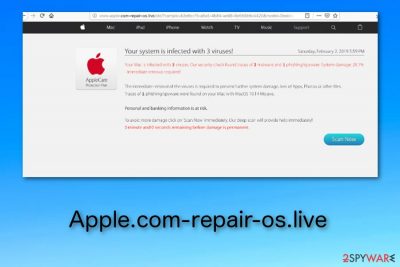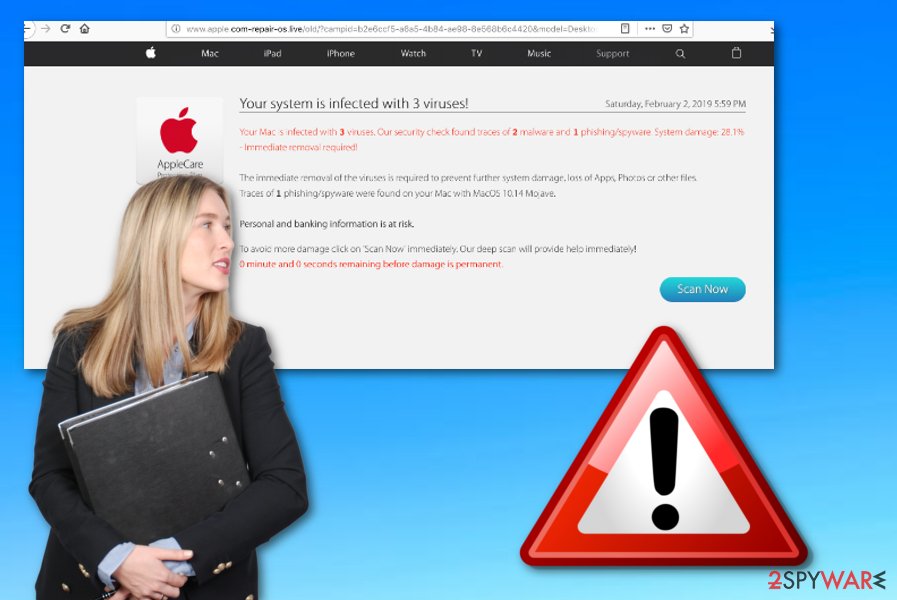Apple.com-repair-os.live (Removal Instructions) - Chrome, Firefox, IE, Edge
Apple.com-repair-os.live Removal Guide
What is Apple.com-repair-os.live?
Apple.com-repair-os.live – a scamming application which claims that your Mac is infected with 3 viruses

Apple.com-repair-os.live is a pop-up scam which appears only on Mac computers. Developers promote such programs by using illegitimate techniques and scaring users that their computers are infected with malware when they truly are not. Once installed in the system, Apple.com-repair-os.live virus might leave rogue content in web browsers such as Google Chrome, Mozilla Firefox, Internet Explorer, Microsoft Edge, etc. However, the worst part of this application is that it provides a message which threatens people that their Mac is infected with 3 viruses, the system is damaged 28,1% and needs fixing right away. Some gullible users do fall for this trick and continue by clicking on the “Scan now” button which can launch the installation of another potentially unwanted program on the computer system.
| Name | Apple.com-repair-os.live |
|---|---|
| Type | Scam |
| Sub-type | PUP |
| Target | Mac machines |
| Purpose | To convince users that their computer is infected and the only way to fix it is by downloading some type of software |
| Detection | FortectIntego can find the PUP and all related content on your Mac PC |
| Elimination | You can delete the pop-up scam with reliable tools or on your own |
If you have overcome the Apple.com-repair-os.live scam on your computer or while browsing, you supposedly have received this type of message:
Your system is infected with 3 viruses!
Your Mac is infected with 3 viruses. Our security check found traces of 2 malware and 1 phishing/spyware. System damage: 28.1% – Immediate removal required! The immediate removal of the viruses is required to prevent further system damage, loss of Apps, Photos or other files. Traces of 1 phishing/spyware were found on your Mac with MacOS 10.14 Mojave. Personal and banking information is at risk.
To avoid more damage click on ‘Scan Now’ immediately. Our deep scan will provide help immediately! 4 minute and 26 seconds remaining before damage is permanent.
Even though these people who have written the message threaten that your system is infected with 3 different viruses and permanent damage will be done if you do not take actions in 4 minutes and 26 seconds, note that this type of information is ALL FALSE! Apple.com-repair-os.live is created to scare Mac users and convince them to download other rogue tools.
This is the main reason why such programs as Apple.com-repair-os.live scam are called scareware.[1] They appear out of nowhere, pretend to be from well-known companies (this time – Apple) and confuse the user by alerting about various system issues and infections found. Again, DO NOT believe in this kind of information as it is just a scam.
If you want to check your system for real issues or infections, you should decide to purchase a strong and expert-tested computer tool to perform a full system scan. Once you receive the results, you will supposedly find out that there are no similarities with the alerts that were provided by Apple.com-repair-os.live on your computer.
If you have been experiencing the fake pop-up scam message just on a particular website, all you have to do is close that page and never return back. However, if pop-ups from this rogue app have been showing up frequently, note that you will need to perform the Apple.com-repair-os.live removal from your Mac computer[2] system and even web browsers.
You might be able to remove Apple.com-repair-os.live virus by using our step-by-step guide that is provided below this article if you are a well-experienced computer user. If not, choose a program such as FortectIntego to scan the entire Mac computer system for cyber infections, and eliminate them with an automatical tool once detected.

Pop-up scams can install from various dubious Internet sources
If you have spotted a rogue scamming application on your computer system, there are a few ways how this PUP reached your machine. According to cybersecurity experts from LosVirus.es,[3] potentially unwanted applications mostly end up on users' computers from:
- third-party websites.[4]
- unsafe downloads.
If you are likely to step on each page you see, you risk getting infected with adware or other PUPs. Make sure that you identify the content first before accessing it. Additionally, use only original installers and downloaders and never skip any installing/downloading steps. For further protection, use the Custom/Advanced installation mode to track all incoming downloads and opt-out all suspicious-looking ones so that they do not reach your computer system.
Apple.com-repair-os.live can be removed within a few clicks
For quick and easy Apple.com-repair-os.live removal, look for a reliable anti-malware program. These tools will take care of the cyber threat and get rid of it within a couple of clicks. Also, this method is recommended for less-experienced computer users so that they do not make any mistakes by trying to eliminate the virus on their own.
However, if you believe that you are capable of deleting the PUP without any help, you can remove Apple.com-repair-os.live virus from your Mac computer system and get rid of rogue content from web browsers such as Google Chrome, Microsoft Edge, Internet Explorer, Mozilla Firefox, and Safari by performing each step shown in our below-provided guide.
You may remove virus damage with a help of FortectIntego. SpyHunter 5Combo Cleaner and Malwarebytes are recommended to detect potentially unwanted programs and viruses with all their files and registry entries that are related to them.
Getting rid of Apple.com-repair-os.live. Follow these steps
Delete from macOS
If you have been experiencing pop-ups form Apple.com-repair-os.live recently, you should get rid of the cause by using these instructions:
Remove items from Applications folder:
- From the menu bar, select Go > Applications.
- In the Applications folder, look for all related entries.
- Click on the app and drag it to Trash (or right-click and pick Move to Trash)

To fully remove an unwanted app, you need to access Application Support, LaunchAgents, and LaunchDaemons folders and delete relevant files:
- Select Go > Go to Folder.
- Enter /Library/Application Support and click Go or press Enter.
- In the Application Support folder, look for any dubious entries and then delete them.
- Now enter /Library/LaunchAgents and /Library/LaunchDaemons folders the same way and terminate all the related .plist files.

Remove from Microsoft Edge
Delete unwanted extensions from MS Edge:
- Select Menu (three horizontal dots at the top-right of the browser window) and pick Extensions.
- From the list, pick the extension and click on the Gear icon.
- Click on Uninstall at the bottom.

Clear cookies and other browser data:
- Click on the Menu (three horizontal dots at the top-right of the browser window) and select Privacy & security.
- Under Clear browsing data, pick Choose what to clear.
- Select everything (apart from passwords, although you might want to include Media licenses as well, if applicable) and click on Clear.

Restore new tab and homepage settings:
- Click the menu icon and choose Settings.
- Then find On startup section.
- Click Disable if you found any suspicious domain.
Reset MS Edge if the above steps did not work:
- Press on Ctrl + Shift + Esc to open Task Manager.
- Click on More details arrow at the bottom of the window.
- Select Details tab.
- Now scroll down and locate every entry with Microsoft Edge name in it. Right-click on each of them and select End Task to stop MS Edge from running.

If this solution failed to help you, you need to use an advanced Edge reset method. Note that you need to backup your data before proceeding.
- Find the following folder on your computer: C:\\Users\\%username%\\AppData\\Local\\Packages\\Microsoft.MicrosoftEdge_8wekyb3d8bbwe.
- Press Ctrl + A on your keyboard to select all folders.
- Right-click on them and pick Delete

- Now right-click on the Start button and pick Windows PowerShell (Admin).
- When the new window opens, copy and paste the following command, and then press Enter:
Get-AppXPackage -AllUsers -Name Microsoft.MicrosoftEdge | Foreach {Add-AppxPackage -DisableDevelopmentMode -Register “$($_.InstallLocation)\\AppXManifest.xml” -Verbose

Instructions for Chromium-based Edge
Delete extensions from MS Edge (Chromium):
- Open Edge and click select Settings > Extensions.
- Delete unwanted extensions by clicking Remove.

Clear cache and site data:
- Click on Menu and go to Settings.
- Select Privacy, search and services.
- Under Clear browsing data, pick Choose what to clear.
- Under Time range, pick All time.
- Select Clear now.

Reset Chromium-based MS Edge:
- Click on Menu and select Settings.
- On the left side, pick Reset settings.
- Select Restore settings to their default values.
- Confirm with Reset.

Remove from Mozilla Firefox (FF)
Use these instructions to clean your Mozilla Firefox web browser from adware-related content:
Remove dangerous extensions:
- Open Mozilla Firefox browser and click on the Menu (three horizontal lines at the top-right of the window).
- Select Add-ons.
- In here, select unwanted plugin and click Remove.

Reset the homepage:
- Click three horizontal lines at the top right corner to open the menu.
- Choose Options.
- Under Home options, enter your preferred site that will open every time you newly open the Mozilla Firefox.
Clear cookies and site data:
- Click Menu and pick Settings.
- Go to Privacy & Security section.
- Scroll down to locate Cookies and Site Data.
- Click on Clear Data…
- Select Cookies and Site Data, as well as Cached Web Content and press Clear.

Reset Mozilla Firefox
If clearing the browser as explained above did not help, reset Mozilla Firefox:
- Open Mozilla Firefox browser and click the Menu.
- Go to Help and then choose Troubleshooting Information.

- Under Give Firefox a tune up section, click on Refresh Firefox…
- Once the pop-up shows up, confirm the action by pressing on Refresh Firefox.

Remove from Google Chrome
If you have spotted some rogue changes in your Google Chrome web browser, you can eliminate them by performing this guide:
Delete malicious extensions from Google Chrome:
- Open Google Chrome, click on the Menu (three vertical dots at the top-right corner) and select More tools > Extensions.
- In the newly opened window, you will see all the installed extensions. Uninstall all the suspicious plugins that might be related to the unwanted program by clicking Remove.

Clear cache and web data from Chrome:
- Click on Menu and pick Settings.
- Under Privacy and security, select Clear browsing data.
- Select Browsing history, Cookies and other site data, as well as Cached images and files.
- Click Clear data.

Change your homepage:
- Click menu and choose Settings.
- Look for a suspicious site in the On startup section.
- Click on Open a specific or set of pages and click on three dots to find the Remove option.
Reset Google Chrome:
If the previous methods did not help you, reset Google Chrome to eliminate all the unwanted components:
- Click on Menu and select Settings.
- In the Settings, scroll down and click Advanced.
- Scroll down and locate Reset and clean up section.
- Now click Restore settings to their original defaults.
- Confirm with Reset settings.

Delete from Safari
Remove unwanted extensions from Safari:
- Click Safari > Preferences…
- In the new window, pick Extensions.
- Select the unwanted extension and select Uninstall.

Clear cookies and other website data from Safari:
- Click Safari > Clear History…
- From the drop-down menu under Clear, pick all history.
- Confirm with Clear History.

Reset Safari if the above-mentioned steps did not help you:
- Click Safari > Preferences…
- Go to Advanced tab.
- Tick the Show Develop menu in menu bar.
- From the menu bar, click Develop, and then select Empty Caches.

After uninstalling this potentially unwanted program (PUP) and fixing each of your web browsers, we recommend you to scan your PC system with a reputable anti-spyware. This will help you to get rid of Apple.com-repair-os.live registry traces and will also identify related parasites or possible malware infections on your computer. For that you can use our top-rated malware remover: FortectIntego, SpyHunter 5Combo Cleaner or Malwarebytes.
How to prevent from getting adware
Stream videos without limitations, no matter where you are
There are multiple parties that could find out almost anything about you by checking your online activity. While this is highly unlikely, advertisers and tech companies are constantly tracking you online. The first step to privacy should be a secure browser that focuses on tracker reduction to a minimum.
Even if you employ a secure browser, you will not be able to access websites that are restricted due to local government laws or other reasons. In other words, you may not be able to stream Disney+ or US-based Netflix in some countries. To bypass these restrictions, you can employ a powerful Private Internet Access VPN, which provides dedicated servers for torrenting and streaming, not slowing you down in the process.
Data backups are important – recover your lost files
Ransomware is one of the biggest threats to personal data. Once it is executed on a machine, it launches a sophisticated encryption algorithm that locks all your files, although it does not destroy them. The most common misconception is that anti-malware software can return files to their previous states. This is not true, however, and data remains locked after the malicious payload is deleted.
While regular data backups are the only secure method to recover your files after a ransomware attack, tools such as Data Recovery Pro can also be effective and restore at least some of your lost data.
- ^ Margaret Rouse. Scareware. What is. Tech target.
- ^ MAC. Computer hope. Free computer help since 1998.
- ^ LosVirus.es. LosVirus.es. Spyware news site.
- ^ Sid Kemp. What is the meaning of a "third party website"?. Quora.com. Questions and answers.




















